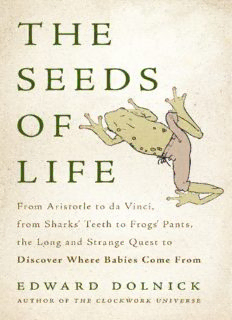
The Seeds of Life: From Aristotle to da Vinci, from Sharks’ Teeth to Frogs’ Pants, the Long and Strange Quest to Discover Where Babies Come From PDF
Preview The Seeds of Life: From Aristotle to da Vinci, from Sharks’ Teeth to Frogs’ Pants, the Long and Strange Quest to Discover Where Babies Come From
Copyright Copyright © 2017 by Edward Dolnick Published by Basic Books, an imprint of Perseus Books, LLC, a subsidiary of Hachette Book Group, Inc. All rights reserved. No part of this book may be reproduced in any manner whatsoever without written permission except in the case of brief quotations embodied in critical articles and reviews. For information, address Basic Books, 1290 Avenue of the Americas, New York, NY 10104. Books published by Basic Books are available at special discounts for bulk purchases in the United States by corporations, institutions, and other organizations. For more information, please contact the Special Markets Department at Perseus Books, 2300 Chestnut Street, Suite 200, Philadelphia, PA 19103, or call (800) 810-4145, ext. 5000, or e-mail [email protected]. DESIGNED BY LINDA MARK Library of Congress Cataloging-in-Publication Data Names: Dolnick, Edward, 1952– author. Title: Seeds of life : from Aristotle to Da Vinci, from sharks’ teeth to frogs’ pants, the long and strange quest to discover where babies come from / Edward Dolnick. Description: New York : Basic Books, [2017] | Includes bibliographical references and index. Identifiers: LCCN 2016054195| ISBN 9780465082957 (hardcover) | ISBN 9780465094967 (ebook) Subjects: LCSH: Human reproduction—History. | Human reproduction— Mythology. | Human reproduction—Social aspects. | BISAC: SCIENCE / History. | HISTORY Social History. | SCIENCE Life Sciences / General. Classification: LCC QP251 .D59 2017 | DDC 612.6—dc23 LC record available at https://lccn.loc.gov/2016054195 LSC E3-20170505-JV-PC CONTENTS Cover Title Page Copyright Dedication Epigraph Time Line PROLOGUE England in the Early 1630s PART ONE: PEERING INTO THE BODY ONE Onward to Glory TWO Hidden in Deep Night THREE Swallowing Stones and Drinking Dew FOUR Unmoored in Time FIVE “Double, Double Toil and Trouble” SIX Door A or Door B? PART TWO: THE SEARCH FOR THE EGG SEVEN Missing: One Universe (Reward to Finder) EIGHT Sharks’ Teeth and Cows’ Eggs NINE The Egg, At Last TEN A World in a Drop of Water ELEVEN “Animals of the Semen” PART THREE: RUSSIAN DOLLS TWELVE Dolls Within Dolls THIRTEEN The Message in God’s Fine Print FOURTEEN Sea of Troubles FIFTEEN The Rabbit Woman of Godliman SIXTEEN “All in Pieces, All Coherence Gone” SEVENTEEN The Cathedral That Built Itself EIGHTEEN A Vase in Silhouette PART FOUR: THE CLOCKWORK TOPPLES AND A NEW THEORY RISES NINETEEN Frogs in Silk Pants TWENTY A Drop of Venom TWENTY-ONE The Craze of the Century TWENTY-TWO “I Saw the Dull Yellow Eye of the Creature Open” TWENTY-THREE The Nose of the Sphinx TWENTY-FOUR “The Game Is Afoot” TWENTY-FIVE Caught! Acknowledgments About the Author Illustration Credits Bibliography Notes Index For Lynn, and Sam and Ben Night and day, the ignorant as well as the learned give themselves over to the pleasure of making children. But no one knows how he has engendered his own progeny. —VITTORE CARDELINI, Italian physician and author, 1628 TIME LINE 1490—Leonardo da Vinci makes a cutaway drawing of a man and woman having sex. 1492—Columbus sets sail. 1543—Andreas Vesalius publishes one of the masterpieces in the history of anatomy. 1543—Copernicus says that the Earth goes around the sun, not vice versa. 1628—William Harvey shows that the heart is a pump. 1651—Harvey declares that “everything comes from the egg.” 1669—Jan Swammerdam argues that God created all the generations of animals at the dawn of time, one inside the next like Russian dolls. 1672—Regnier de Graaf (almost) proves that female mammals have eggs. 1674—Antony van Leeuwenhoek sees countless “tiny animals,” invisible to the naked eye, in a drop of pond water. 1677—Leeuwenhoek sees spermatozoa by the millions. 1694—Nicolaas Hartsoeker draws a miniature man inside a sperm cell. 1741—Abraham Trembley cuts a tiny organism called a hydra into pieces. Miraculously, each piece grows into a complete creature. 1745—French scientists propose a new theory of how living organisms develop: life is regulated not by clockwork but by a force akin to gravity. 1752—Ben Franklin flies a kite during a thunderstorm and proves that lightning is electrical. 1770s—Lazzaro Spallanzani puts male frogs in boxer shorts. 1776—American Revolution begins. 1791—Luigi Galvani zaps frog legs with electricity. 1818—Mary Shelley publishes Frankenstein. 1827—Karl von Baer becomes the first to see a mammal’s egg. 1837—Queen Victoria takes the throne. 1830s–1860s—Cell theory emerges. 1861–1865—The American Civil War lasts four long years. 1875—Oscar Hertwig witnesses the union of sperm and egg.
Description: